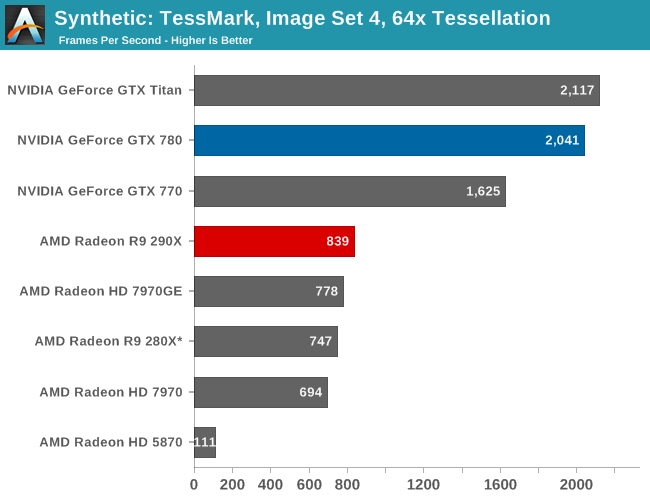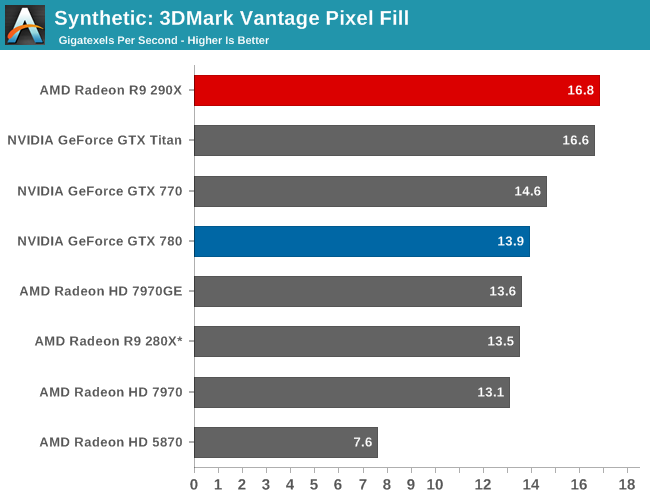The AMD Radeon R9 290X Review
by Ryan Smith on October 24, 2013 12:01 AM EST- Posted in
- GPUs
- AMD
- Radeon
- Hawaii
- Radeon 200
Synthetics
As always we’ll also take a quick look at synthetic performance. The 290X shouldn’t pack any great surprises here since it’s still GCN, and as such bound to the same general rules for efficiency, but we do have the additional geometry processors and additional ROPs to occupy our attention.

Right off the bat then, the TessMark results are something of a head scratcher. Whereas NVIDIA’s performance here has consistently scaled well with the number of SMXes, AMD’s seeing minimal scaling from those additional geometry processors on Hawaii/290X. Clearly Tessmark is striking another bottleneck on 290X beyond simple geometry throughput, though it’s not absolutely clear what that bottleneck is.
This is a tessellation-heavy benchmark as opposed to a simple massive geometry bencehmark, so we may be seeing a tessellation bottleneck rather than a geometry bottleneck, as tessellation requires its own set of heavy lifting to generate the necessary control points. The 12% performance gain is much closer to the 11% memory bandwidth gain than anything else, so it may be that the 280X and 290X are having to go off-chip to store tessellation data (we are after all using a rather extreme factor), in which case it’s a memory bandwidth bottleneck. Real world geometry performance will undoubtedly be better than this – thankfully for AMD this is the pathological tessellation case – but it does serve of a reminder of how much more tessellation performance NVIDIA is able to wring out of Kepler. Though the nearly 8x increase in tessellation performance since 5870 shows that AMD has at least gone a long way in 4 years, and considering the performance in our tessellation enabled games AMD doesn’t seem to be hurting for tessellation performance in the real world right now.
Moving on, we have our 3DMark Vantage texture and pixel fillrate tests, which present our cards with massive amounts of texturing and color blending work. These aren’t results we suggest comparing across different vendors, but they’re good for tracking improvements and changes within a single product family.

Looking first at texturing performance, we can see that texturing performance is essentially scaling 1:1 with what the theoretical numbers say it should. 36% better texturing performance over 280X is exactly in line with the increased number of texture units versus 280X, at the very least proving that 290X isn’t having any trouble feeding the increased number of texture units in this scenario.

Meanwhile for our pixel fill rates the results are a bit more in the middle, reflecting the fact that this test is a mix of ROP bottlenecking and memory bandwidth bottlenecking. Remember, AMD doubled the ROPs versus 280X, but only gave it 11% more memory bandwidth. As a result the ROPs’ ability to perform is going to depend in part on how well color compression works and what can be recycled in the L2 cache, as anything else means a trip to the VRAM and running into those lesser memory bandwidth gains. Though the 290X does get something of a secondary benefit here, which is that unlike the 280X it doesn’t have to go through a memory crossbar and any inefficiencies/overhead it may add, since the number of ROPs and memory controllers is perfectly aligned on Hawaii.










396 Comments
View All Comments
Bloodcalibur - Thursday, October 24, 2013 - link
Your dumb ass paid $350 extra for computing performance when all you do is game LOL!eddieveenstra - Sunday, October 27, 2013 - link
+10blau808 - Thursday, October 24, 2013 - link
The 780ti will easily beat the 290 for price/performanceBlack Obsidian - Thursday, October 24, 2013 - link
So you're anticipating greater than Titan performance for less than 290X pricing?If so, you might be interested in this bridge I have for sale. It's in Brooklyn. In good shape, available real cheap.
Bloodcalibur - Thursday, October 24, 2013 - link
Titan is a gaming/workstation hybrid. That's why it costs $350 more than 780 with only a small gaming performance increase. You sounded really ignorant there lolol.erple2 - Thursday, October 24, 2013 - link
Too easy. Too easy. You need to actually read the post Above you before commenting on the price comparison.rituraj - Thursday, October 24, 2013 - link
No.Naxirian - Thursday, October 24, 2013 - link
Lol.... except it loses to the 780 in a bunch of benchmarks, a card that has already been on the market for 6 months and costs exactly the same as the R9 290X does. Not to mention the 780 Ti is due out next month, and from the looks of these benchmarks, will probably murder the 290X whilst being in the same price range. AMD are late to the party yet again. Wonder what they'll do when Nvidia launch the 800 series next year lol. Probably wait 9 months and then launch another out-dated gen like this time.extide - Thursday, October 24, 2013 - link
What planet are you on? The 290x is $100 cheaper, NOT the same price. AMD also had the 7970 out before nVidia had any 28nm cards out, so they weren't behind. Right now the 290x is the best bang/buck card period, and if you game in 4K it is THE best card. Facts are facts man....QuantumPion - Thursday, October 24, 2013 - link
According to the benchmarks it is only faster than the Titan at 4k resolution (probably due to its 4 gb ram and higher memory bandwidth). At normal resolutions it is about on par with the 780 depending on the game. So it is about on par with the 780 and ~$50 cheaper - we've yet to see what the 780 Ti can do though. Why the article claims the 290X is faster than the Titan and only $550 makes it seem like it was written before the actual benchmarks were performed.